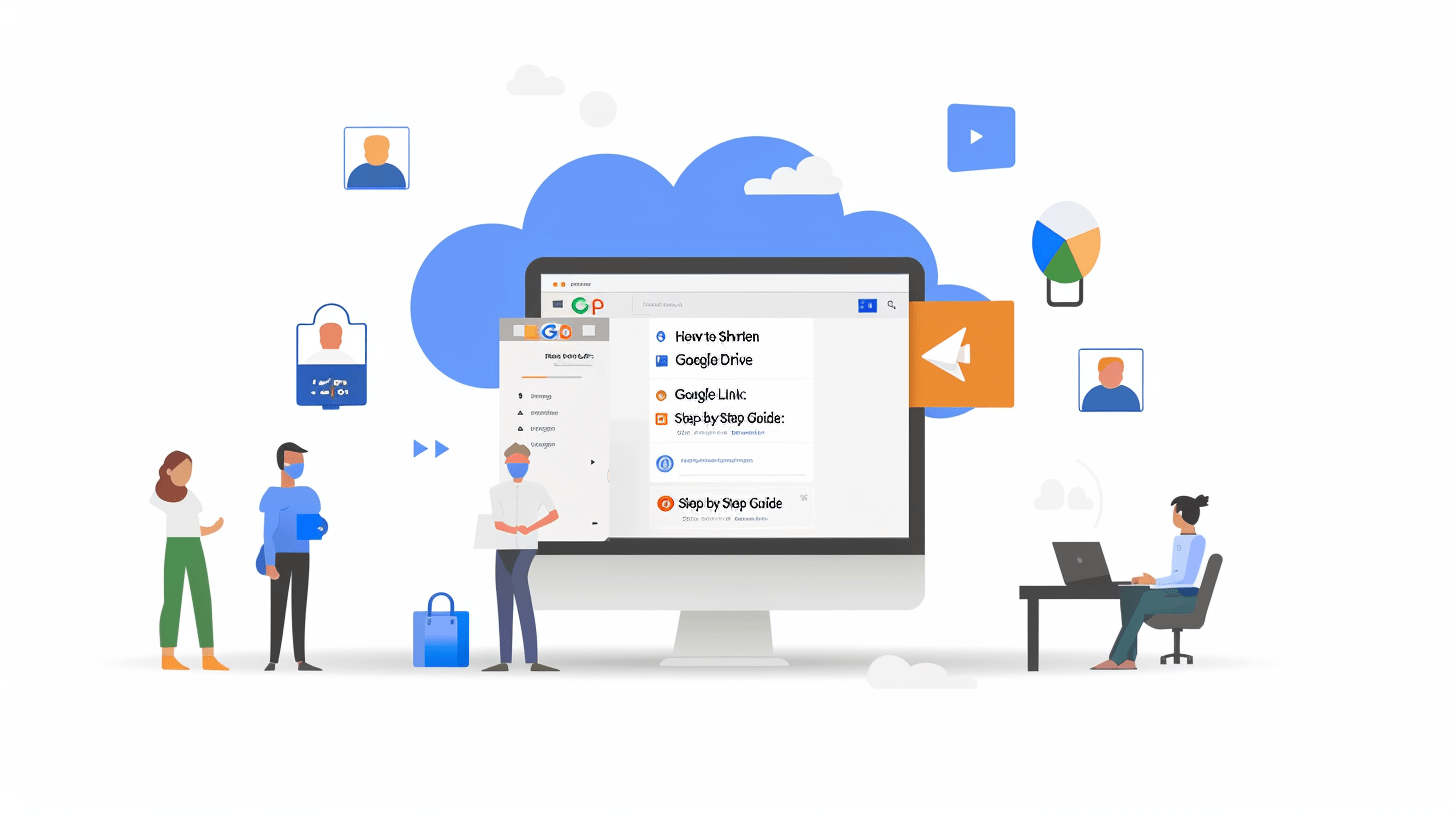How to Shorten a Google Drive Link: A Step-by-Step Guide

Rez Moss
Apr 2, 2024
Introduction
In our digitally connected world, sharing files and resources has become a cornerstone of collaboration and communication. Google Drive, with its robust platform for storing and sharing various types of documents, stands as a pivotal tool in this exchange. However, one often overlooked aspect of sharing these valuable resources is the cumbersome nature of the links generated by Google Drive. Typically long and unwieldy, these URLs can be intimidating, difficult to remember, and challenging to share, especially on platforms with character limits or in print materials.
This is where the concept of URL shortening emerges as an elegant solution to a modern problem. URL shorteners transform lengthy links into more manageable versions, making them easier to share, remember, and even customize. Beyond the sheer convenience, shortened URLs offer additional benefits such as the ability to track engagement and clicks, providing insights into the effectiveness of shared content. Furthermore, they allow for a level of customization that can enhance brand presence and make links more personal or relevant to the audience.
In the context of sharing content online, adhering to the EAT (Expertise, Authoritativeness, and Trustworthiness) guidelines is crucial. These guidelines, established to evaluate the quality and reliability of online content, underscore the importance of presenting shared materials in a professional and trustworthy manner. Shortening URLs, particularly when using reputable services, can contribute significantly to this endeavor. It not only simplifies the sharing process but also ensures that the links maintain a level of professionalism and security, reflecting positively on the sharer's credibility.
As we delve deeper into the nuances of Google Drive link shortening, it's essential to recognize this practice as more than a mere convenience. It's a strategic approach to digital communication that aligns with broader principles of clarity, accessibility, and trustworthiness. Whether you're an educator sharing resources with students, a professional distributing materials to colleagues, or anyone in between, understanding and utilizing URL shortening can markedly improve your digital interactions and the presentation of your shared content.
Understanding Google Drive Link Shortening
Shortening a Google Drive link transforms a lengthy URL into a concise, manageable version, enhancing the sharing experience significantly. This transformation is not just about aesthetics or convenience; it's about making digital content more accessible and engaging. Shortened links are easier to incorporate into text messages, emails, social media posts, and even printed materials, where space is limited or where a cleaner, more professional look is desired.
One of the most compelling features of link shorteners is the ability to customize the resultant URLs. This customization can range from embedding brand names to incorporating specific keywords, making the links not only shorter but also more meaningful and memorable. Moreover, many URL shortening services offer tracking capabilities, providing valuable insights into how the links are being used. This data can include the number of clicks, the geographic location of users, and the platforms from which the link was accessed. For Google Drive links, which are often shared to disseminate information, gather feedback, or collaborate on projects, these analytics can be incredibly useful.
Link shortening also aligns with the EAT guidelines by enhancing the professionalism and credibility of the shared content. A shortened link, especially one that is customized, appears more trustworthy and authoritative than a long, unwieldy URL filled with random characters. Furthermore, using reputable URL shortening services can ensure that the links remain secure and functional, reducing the risk of broken links or security warnings that can detract from the user's experience and the sharer's credibility.
In the realm of Google Drive, where files and folders are often shared across diverse platforms and audiences, the advantages of link shortening are manifold. Whether it's a teacher sharing educational materials, a business distributing reports, or a creative sharing their portfolio, a shortened Google Drive link can make the process smoother and more effective. It enhances the recipient's experience by providing them with a clean, simple link, and it gives the sharer insights into how their materials are being engaged with, offering opportunities to adjust and improve sharing strategies over time.
Thus, understanding Google Drive link shortening is more than just learning how to use a tool; it's about embracing a practice that enhances digital communication. It respects the user's time and attention, ensures content is presented in the best possible light, and upholds the principles of expertise, authoritativeness, and trustworthiness that are so valued in today's digital landscape.

Choosing a URL Shortening Service
When it comes to shortening Google Drive links, the choice of URL shortening service is pivotal. The market offers a plethora of options, each with its unique features and benefits. Among the most renowned services are Bitly, Zlnk and TinyURL, and others that have stood the test of time due to their reliability, ease of use, and range of functionalities. Selecting the right service goes beyond just shortening a URL; it involves considering security, customization options, tracking capabilities, and, importantly, the service's reputation and trustworthiness.
Bitly is a powerhouse in the URL shortening domain, known for its robust analytics and extensive customization options. It allows users to create short links that are not only concise but also branded, which can significantly enhance brand visibility and recall. For those sharing Google Drive links in a professional or business context, Bitly's features offer a way to track engagement and understand how content is being accessed and shared.
Zlnk distinguishes itself as a user-friendly URL shortening service, tailored for both individuals and businesses seeking efficiency without the complexity of extensive tracking features. It provides an intuitive platform for creating short, manageable links ideal for sharing on social media, emails, or anywhere space is limited. While it offers basic analytics to understand link performance, its main appeal lies in its straightforward approach — no account is necessary to start simplifying URLs. This makes Zlnk.com an attractive option for users prioritizing ease of use and quick link generation over detailed statistical analysis.
TinyURL, on the other hand, offers simplicity and ease of use, making it a favorite for users looking for a straightforward solution without the need for detailed analytics. Its ability to quickly generate short links without the need for an account makes it accessible for casual use, where tracking is not a priority but simplicity is.
When choosing a URL shortening service, consider the following factors:
- Security: Ensure the service has a good track record of security and reliability. A compromised link can lead to phishing sites or other security risks.
- Reliability: The service should guarantee that the links will remain active and accessible over time. Broken links can detract from the credibility of the content shared.
- Costs: While many services offer free versions, advanced features such as detailed analytics or branded links may require a subscription. Consider your needs and budget.
- Features: Evaluate what features are most important for your sharing needs. If you're looking to track the performance of your links, choose a service that offers comprehensive analytics.
Aligning with the EAT guidelines, using established and reputable URL shortening services ensures that the shortened links are safe and trustworthy. This not only protects the content but also the image of the individual or organization sharing it. In a digital landscape where trust is paramount, the choice of a URL shortening service is a reflection of one's commitment to security, professionalism, and reliability.
Choosing the right URL shortening service for Google Drive links is a crucial step in ensuring that shared content is accessible, secure, and engaging. By carefully considering the available options and aligning them with specific needs and values, users can enhance their sharing practices, making them more effective and trustworthy.
Step-by-Step Guide to Shortening Your Google Drive Link
Shortening a Google Drive link enhances the accessibility and professionalism of your shared content. This guide uses Zlnk, a popular URL shortening service known for its user-friendly interface and effective link management features. This process can be adapted for other URL shortening services, but Zlnk is chosen here for its simplicity and efficiency.
Obtaining Your Shareable Google Drive Link
- Navigate to Google Drive: Open your Google Drive and find the file or folder you wish to share.
- Get Shareable Link: Right-click on the item and choose "Get shareable link" from the context menu. Adjust the sharing settings to your preference to control whether the audience can view, comment on, or edit the content.
- Copy the Link: The shareable link is now on your clipboard. This long URL is what we'll be shortening with Zlnk.
Using Zlnk to Shorten the Link
- Sign Up/Login to Zlnk: Go to the Zlnk website. You'll need to sign up if you're a new user or log in if you already have an account. Zlnk offers a straightforward interface with an option for free accounts, which are sufficient for basic link shortening.
- Paste Your Link: Look for the option to create a new short link, often indicated with a plus (+) symbol or labeled "Create" or "Shorten." Click this and paste your Google Drive link into the designated field.
- Shorten the Link: Click the "Shorten" button after pasting your URL. Zlnk will generate a concise version of your link immediately.
- Customize (Optional): While Zlnk’s free version offers basic shortening capabilities, upgrading to a premium account may provide additional features like link customization. This allows you to tailor the shortened URL, making it more descriptive or relevant to your content.
Testing and Sharing Your Shortened Link
- Test the Link: It's important to verify that your shortened link directs to the correct Google Drive item before sharing. Simply click on the Zlnk-provided URL or enter it into a web browser to ensure it leads to the intended destination.
- Share with Confidence: Once you've confirmed that your shortened link works as expected, you’re ready to distribute it through your preferred channels, be it email, social media, or another medium.
Tips for Customizing Your Shortened Link
- Choose Descriptive Customizations: If you're able to customize your shortened link, select a keyword or phrase that reflects the content’s nature or purpose. This approach aids in recall and can potentially increase engagement.
- Consistency in Branding: For those with access to customization features, incorporating recognizable elements of your brand, like a name or slogan, can further reinforce brand identity with each link shared.
Best Practices for Sharing Shortened Google Drive Links
Sharing shortened Google Drive links effectively requires more than just creating a concise URL. It involves ensuring that the content is accessible to your intended audience and that sharing practices enhance the document's value while maintaining privacy and security. Here are some best practices to follow:
Confirming Privacy Settings on Google Drive
- Check the Link's Access Settings: Before sharing your shortened Google Drive link, it’s essential to verify who can access the link. Google Drive allows you to set access levels such as "Anyone with the link can view," "Anyone with the link can comment," and "Anyone with the link can edit." Choose the setting that best matches your intentions for sharing the document.
- Limit Editing Permissions: Unless collaboration is intended, it's advisable to restrict the link to "view" or "comment" permissions to prevent unauthorized edits or alterations to your document.
Understanding Your Audience
- Know the Recipients: Tailor the way you share the link based on who will be receiving it. For professional settings, include the link in a well-structured email with a brief description of the document. For more informal settings, a direct message or social media post might be more appropriate.
- Provide Context: Whenever you share a shortened link, accompany it with a brief explanation of what the recipient will find upon clicking. This context is crucial for ensuring that recipients understand the link’s relevance and are more inclined to engage with the content.
Tracking Performance
- Utilize Analytics: If your URL shortening service provides analytics, take advantage of this feature to track the performance of your shortened link. Understanding how many clicks your link receives can inform you about the level of engagement and interest in your content.
- Adjust Based on Feedback: If analytics reveal lower engagement than expected, consider revising how you share the link or the content itself to better meet your audience's needs or interests.
Security and Compliance
- Regular Checks: Periodically verify that your shortened links are active and lead to the correct Google Drive document. This is especially important for critical or frequently accessed documents.
- Update as Necessary: If you update the document or its location within Google Drive, ensure that the shortened link is also updated to reflect these changes. This maintains the link’s usefulness and prevents confusion.
By adhering to these best practices, you can share your shortened Google Drive links more effectively, ensuring that your content is accessed and appreciated by your intended audience. Additionally, these practices help maintain the security and integrity of your shared documents, reinforcing trust and reliability in your digital communications.

Ensuring Security and Compliance with EAT Guidelines
When sharing shortened Google Drive links, it's crucial to prioritize security and compliance with the EAT (Expertise, Authoritativeness, and Trustworthiness) guidelines. These practices not only protect the content but also enhance the credibility and reliability of the sharer. Here’s how to ensure your sharing practices align with these principles:
Using Trusted Shortening Services
- Select Reputable Services: Opt for URL shortening services with a strong reputation for security and reliability. Services that offer features like link encryption and the ability to track and manage your links contribute to a safer sharing environment.
- Avoid Suspicious Services: Be wary of new or unknown link shortening services that might not have robust security measures in place. Using such services can lead to compromised links, which detract from your credibility and could potentially harm your audience.
Enhancing the Authoritativeness of Shared Content
- Verify Content Before Sharing: Ensure that the documents or content you're sharing via Google Drive are accurate, up-to-date, and valuable to your audience. Sharing high-quality, authoritative content reflects positively on your expertise and reliability.
- Provide Context and Value: When sharing a shortened link, include a brief introduction or explanation of the content. This not only helps with SEO but also establishes the context and demonstrates the value of the content, further enhancing your authoritativeness.
Maintaining Trustworthiness
- Be Transparent About Content: Clearly state what the recipient can expect to find after clicking on your shortened link. Surprise redirects or misleading links can damage your trustworthiness and discourage engagement.
- Regularly Review and Update Links: Check your shortened links periodically to ensure they're still active and secure. Updating links to reflect the most current content helps maintain trust with your audience.
Regular Checks for Link Security
- Monitor Link Performance: Use the analytics provided by your URL shortening service to monitor how your links are being accessed and shared. Unusual spikes in traffic or unexpected sources can indicate security issues.
- Stay Informed About Security Practices: Keep up-to-date with best practices for digital security, including the use of secure URLs (https) and awareness of phishing or scamming techniques.
By adhering to these guidelines, you can ensure that your practice of sharing shortened Google Drive links not only enhances the accessibility and engagement of your content but also upholds the highest standards of expertise, authoritativeness, and trustworthiness. This commitment to quality and security in your digital communications will contribute significantly to building and maintaining a credible and trusted online presence.
Conclusion
Shortening Google Drive links offers a practical solution to the challenge of sharing long, cumbersome URLs, transforming them into concise, manageable, and shareable links. This process not only simplifies the act of sharing but also enhances the accessibility and aesthetic appeal of your links, making them more appealing to your audience. By choosing a reputable URL shortening service, you can add a layer of professionalism to your shared content, aligning with the EAT (Expertise, Authoritativeness, and Trustworthiness) guidelines and ensuring that your digital communications reflect your credibility and reliability.
The benefits of shortening your Google Drive links are clear. It allows for easier sharing across various platforms, enhances the presentation of your links, and can even provide valuable insights through link tracking and analytics. Moreover, adhering to best practices in sharing shortened links—such as verifying privacy settings, understanding your audience, and ensuring the security of your links—further ensures that your content is accessed and appreciated by your intended audience while maintaining the integrity and security of the shared documents.
In conclusion, adopting the practice of shortening Google Drive links is more than just a convenience; it's a strategic approach to digital communication. It speaks to a broader commitment to clarity, accessibility, and trustworthiness in the sharing of digital content. As we move forward in an increasingly digital world, embracing tools and practices that enhance our digital interactions is essential. Whether you're sharing educational materials, business documents, or creative projects, shortened Google Drive links can significantly improve how your content is shared, received, and engaged with.
We encourage readers to adopt these practices for more effective and professional sharing of Google Drive content. If you have experiences or questions about shortening Google Drive links, feel free to share them for further discussion. This collaborative approach not only enriches our collective understanding but also fosters a community of informed and conscientious digital citizens.